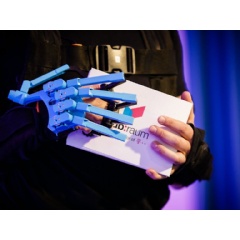See, feel, throw with 5G - Startup pioneers at Deutsche Telekom
-Startups at DT’s hubraum develop 5G applications
-Developers testing ideas in DT’s 5G test field in Berlin
-18 startups from nine countries participate in hubraum’s 5G prototyping program
They are the first in Germany to already use 5G live and in colour - for real-time information during sports, training sessions with AR glasses and data gloves or self-propelled robots in factories. 18 startups in the Telekom Tech incubator hubraum tested their 5G ideas over the past few months. They had live conditions at Telekom’s 5G test field in Berlin. There, they also had the possibility to use Edge Computing. With this technology, the network reacts without delay because the computing power in the cloud is close to the user. The 5G pioneers gained experience on how to implement their ideas with 5G and Edge Computing.
“The results show which of the first 5G services are most relevant”“We deliberately opened our 5G and Edge infrastructure to startups at a very early stage. We learned a lot from working together to implement their 5G ideas,” says Claudia Nemat, Board Member Technology and Innovation at Deutsche Telekom. “The feedback from the 5G pioneers has shown us how future applications can benefit from the combination of 5G and edge computing. In addition, the results show which of the first 5G services are most relevant. Especially in education and entertainment, the possibilities of virtual and augmented reality and gaming are very promising.”
The results of the hubraum 5G prototyping program are impressive. All 15 projects have turned their ideas into 5G products and present them this week at the hubraum Prototyping Summit. Projects from very different areas have emerged. The company immersiv.io has developed a platform for augmented reality for big live sports events. This allows viewers to call up additional information about the game in real time. The product was used live at Telekom Baskets basketball games. Fans could, for example, check on their smartphone or AR glasses how fast individual players are and how many baskets they have thrown. An extremely low network latency is important for the product to guarantee additional information about the game in real time.
The aim is to train very large companies with large user groupsWhere does the wrench have to be used, what is hidden behind a cover, where is a repair necessary? A project consisting of three startups is working on solutions for training on virtual reality. The aim is to train also very large companies with large user groups using data glassesvia virtual reality streaming. A 5G network with edge computing is suitable for this, so that high-resolution images with high data volumes can be transferred to small and light devices. Innoactive offers the platform for the contents of the training courses. The startup QuarkVR realizes the required streaming of the data over 5G. And to ensure that training courses also address tactile skills, the startup SenseGlovedeveloped a haptic glove. With this glove objects can be moved virtually. This requires an extremely fast response time in the network, since feeling simply happens in fractions of a second.
EK Automation relies on campus networks and self-propelled robots. They can support production and logistics in smart factories. The intelligence of the so-called Automated Guided Vehicles is mainly located in the cloud and needs a fast connection. The AGVs can be used in campus networks of companies. The functionality was successfully tested in the 5G test field.
The focus is on commercializationAfter the completion of the hubraum 5G prototyping program,the ideas and products are checked individually, to see how to continue with them. The focus is on commercialization. This can happen, for example, in cooperation with Telekom’s Partnering division or the 5G program for campus networks, or via a follow-up program in hubraum. Currently, hubraum is considering setting up a program for virtual and augmented reality, for example.
Deutsche Telekom has set up the 5G prototyping program with hubraum to accelerate the development of new applications for 5G. Since the end of 2018, 18 startups have developed their ideas in 15 projects. The teams come from nine countries: Bulgaria, Denmark, Finland France, Great Britain, Israel, the Netherlands, Poland and Germany. The startups use the Berlin 5G testbed and the Edge Cloud of Deutsche Telekom. The Berlin 5G Cluster has been active since May 2018 and now consists of 66 antennas.
About hubraum
hubraum connects the digital startup ecosystem with Deutsche Telekom, linking tech entrepreneurs and high growth startup companies with the expert network, capital, and business opportunities of Deutsche Telekom. hubraum offers various programs out of three locations in Berlin, Krakow and Tel-Aviv. Start-ups can benefit from seed financing, co-working space, mentoring, networking events and connections to Deutsche Telekom business units as well as access to customers.
( Press Release Image: https://photos.webwire.com/prmedia/6/243140/243140-1.jpg )
WebWireID243140
This news content was configured by WebWire editorial staff. Linking is permitted.
News Release Distribution and Press Release Distribution Services Provided by WebWire.
